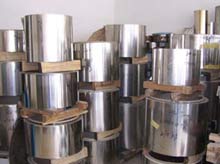- : 0086-21-61182423
- : 0086-21-61182425
- : [email protected]
- : Room 301,Unit 6,lane 2500,xiupu Road,Kangqiao Industrial Area,Pudong New District,Shanghai
- Improper welding of X80 pipeline may cause cracks
- Brief introduction of API X52 pipeline steel
- The difference between PSL1 and PSL2
- Harm of inclusions in X70 pipeline steel
- API 5L pipeline pipe
- X52 steel plate surface quality standards that need to be met
- The basic production process of API 5L X60 pipeline steel
- The key to Q460D steel welding process
- What does the heat treatment of Q690 Steel include?
- Reasons for choosing Q690D steel
316 stainless steel strip

Type 316 stainless steel contains molybdenum for better corrosion resistance - particularly to pitting. Machinability - 45%. Drawing or stamping - good. Welding - very good, tough welds.
316 stainless steel strip,under ASTM standard, we can regard 316 for heat-corrosion-resistant stainless steel strip ,austenitic stainless steel. It is equivalent to 0Cr17Ni12Mo2,but better than 304 stainless steel plate.
316 stainless steel strip properties :
| Hardness |
Yield Strength |
Tensile Strength |
Elongation |
Area reduction |
||
|
HV |
HRB |
HB |
≥ 205 |
≥ 520 |
≥ 40 |
≥60 |
|
≤ 200 |
≤90 |
≤187 |
||||
316 stainless steel strip Mechanical Property :
Tensile Strength N/mm2 |
≥520 |
|
|
Yield Strength N/mm2 |
≥205 |
|
|
Elongation % |
≥40 |
|
|
Hardness |
HB |
≤187 |
|
HRB |
≤90 |
|
|
HV |
≤200 |
|
|
Density g/cm3 |
7.93 |
|
|
Specific Heat J/g ℃ |
0.502c (20℃) |
|
|
Heat Conductivity λ/ W/m℃ |
12.1 (20℃ ) |
|
|
16.3 (100℃) |
||
|
21.4 (500℃) |
||
|
Linear Expansivity α/(10-6/℃) |
16 (20-100) |
|
|
16.8 (20-200) |
||
|
17.5 (20-300) |
||
|
18.1 (20-400) |
||
|
Resistivity |
0.73 Ω*mm2/m |
|
|
Melting Point ℃ |
1398-1420 |
|
316stainless steel is an austenitic chromiumn icke l stainless steel containing molybdenum. This addition increases general corrosion resistance, improves resistance to pitting from chloride ion
solutions, and provides increased strength at elevated temperatures. Properties are similar to those of Type 304 except that this alloy is somewhat stronger at elevated temperatures . Corrosion resistance is improved, particularly against sulfuric, hydrochloric, acetic, formic and tartaric acids; acid sulfates and alkaline chlorides.